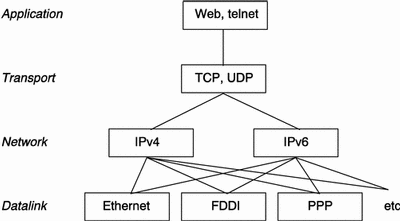Implementing Dual Stack
The dual stack term normally refers to a complete duplication of all levels in the protocol stack from applications to the network layer. An example of this would be OSI and TCP/IP protocols running on the same machine. However, in the context of IPv6 transition, it means a protocol stack contains both IPv4 and IPv6, with the rest of the stack being identical. Consequently, the same transport protocols (TCP, UDP, and so on) and the same applications will run over both IPv4 and IPv6.
The following figure illustrates dual stack protocols through the OSI layers.
Figure 15-1 Dual Stack Protocols

In the dual stack approach, subsets of both hosts and routers are upgraded to support IPv6, in addition to IPv4. This ensures that the upgraded nodes can always interoperate with IPv4-only nodes by using IPv4. Thus, upgrading from IPv4 to dual stack does not break anything.
- © 2010, Oracle Corporation and/or its affiliates
